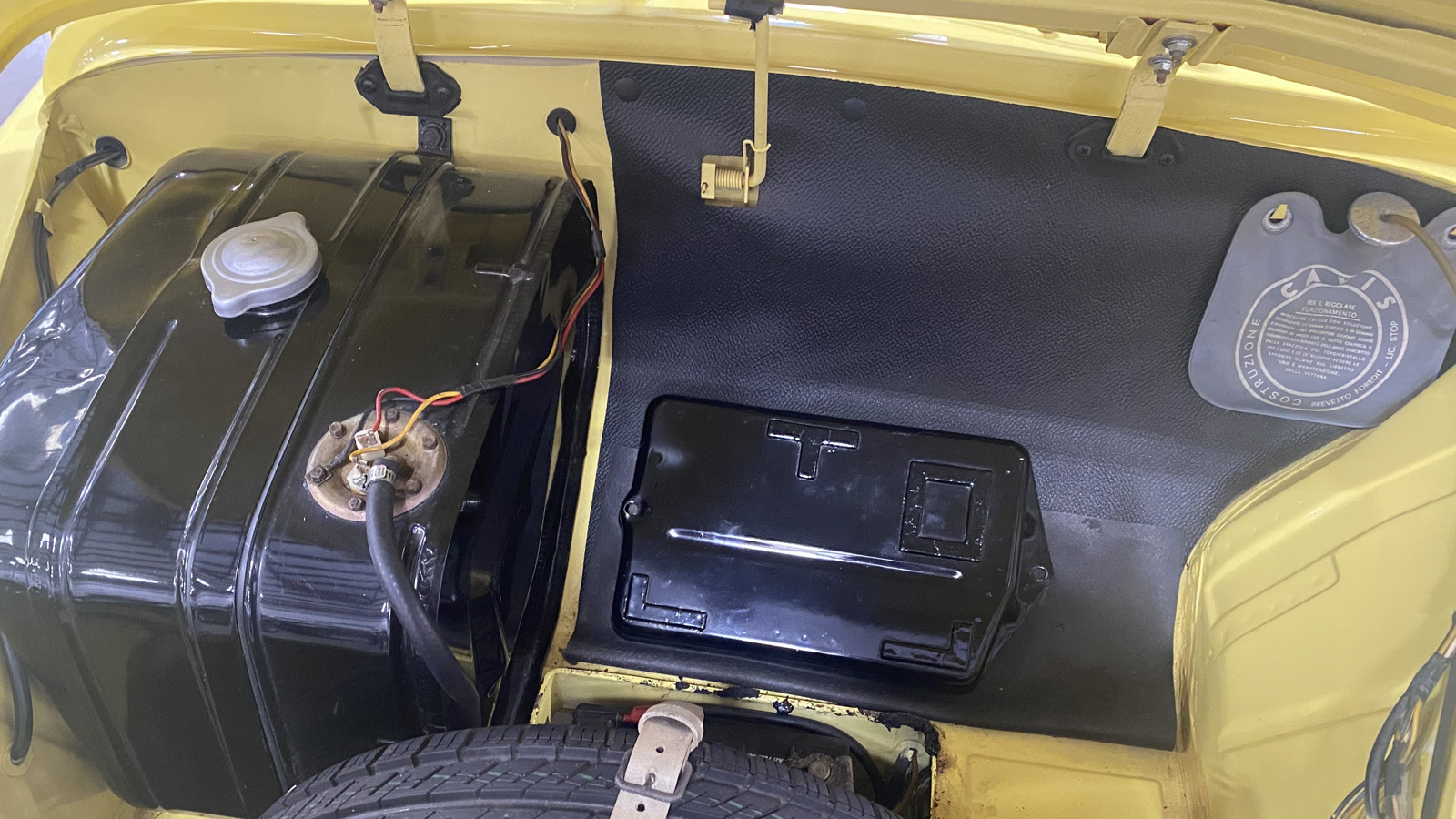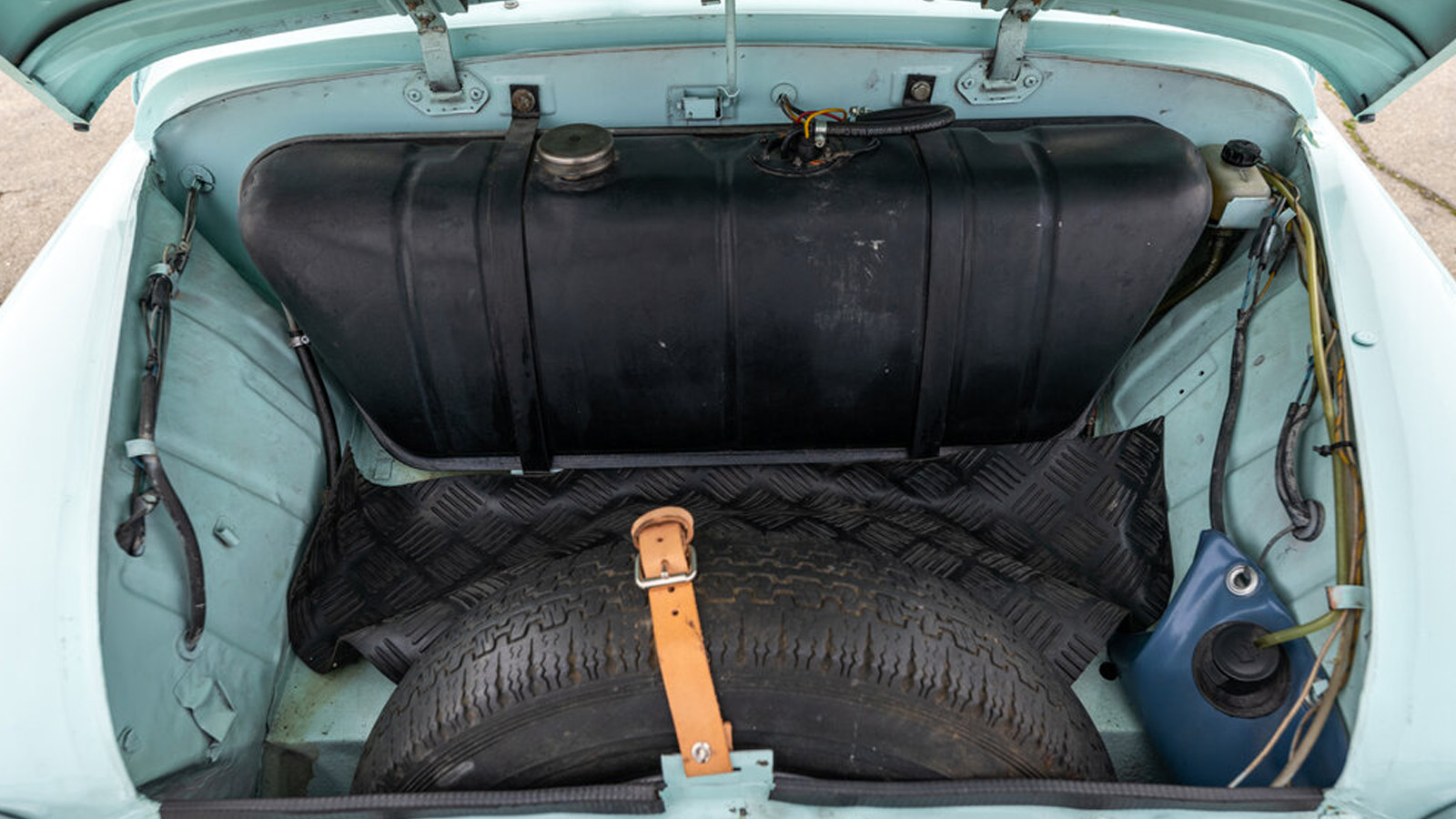As mentioned earlier, Monday I was at Duncan Imports shooting a bunch of videos, which also means I was surrounded by lots of great cars. One that really caught my eye was this absolutely charm-slathered yellow Fiat 600, a car I’ve always liked, as it’s the perfect spot if a Volkswagen Beetle is just too much car for you and yet a Fiat 500 is just not enough. One of the things I like best about the 600 is contemplating the beautiful mystery of its trunk. Rear-engine car front trunks, or, to use a vulgarism, frunks, are often tricky packaging challenges, and the 600 is one where you can see those challenges manifest right before your eyes.

The Fiat 600 is quite reminiscent of the most famous of rounded rear-engine cars, the VW Beetle. Their approaches to frunk design, though, are quite different. If we look at a cutaway Beetle, we can see that the floor of the trunk is formed by the fuel tank:

This isn’t a bad solution, and was similar to what was done on many rear-trunked cars back in the day, too. The 600 takes a very different approach, pushing the fuel tank to one side:

This is interesting; essentially, it buys depth in the trunk at the expense of width. Oh and ignore that battery cover on the floor of the trunk above there; it should be, you know, covering the battery-hole right behind the spare tire. So, does it make sense to provide more depth instead of width? Maybe? That’s not a bad volume of space they’ve carved out there? It’s tricky to see in a side cutaway, because we see the side of the fuel tank:

Also note that like a Beetle, the 600 has a little luggage well behind the rear seat, too. But, we’re talking frunks. Fiat actually re-considered the fuel-and-stuff-side-by-side approach later on, when they re-designed the fuel tank to look like this:

Okay, so here we retain the depth of the trunk, we gain width, at the expense of length. I think this is a pretty good solution, perhaps better than the side-by-side method, because it seems to take into account the general shape of one of the most likely things to be shoved in here, a suitcase or duffel bag or something like that.
Regadless, it’s something to contemplate throughout your day! Something important.




About the “asymmetrically” placed fuel tank in Fiat 600, what about the right-hand-drive version? Switching the places with the steering column and such?
My Renault 4CVs get around all this by putting the fuel tank in the back, under the right side of the rear seat so you only have the spare up in the frunk.
Corvairs had the spare tire in the rear engine compartment for the same reason. I think ’61-up ‘Vairs held the record for biggest frunk ever until the Hummer EV and Ford Lightning came along.
The Subaru Brat had the spare on top of the bell housing under the hood. I suppose that really maximizes bed space, and if the car is stuck in the mud, opening the hood is definitely easier than lowering it from under the rear bumper like many other trucks do.
By the time Fiat got to the Fiat 850, the fuel tank had moved to under the parcel shelf above the gearbox, so you lost the storage behind the rear seats (which would have been awkward to get to anyway) but gained room in the frunk, and avoided the possibility of your luggage smelling like fuel.
And when the 850 was replaced by the Fiat 127 they moved the whole powertrain to the front, but didn’t give the two-box shape the hatchback it was screaming for until a year later and then only as an option.
We’ve come full circle on this today. Without car reviews, we’d have no idea of how much storage space is under the hood (frunk lid?) of an EV. The possibilities range from no cargo space at all (VW) to massive (Ford Lightning).
When I first glanced at the cutaway picture, I thought there was a small Vatican cardinal in the back there.
It’s actually an illustration from a German children’s book called “Das Kleine Kardinal,” about a young boy who rises quickly through the ranks of the church, but has to have his parents drive him around. Surprised Jason found a copy; it’s been out of print for decades.
FIREWALL !
What’s the little colostomy bag on the right of the first frunk pic? Blinker fluid reservoir?
I believe that would be the wiper fluid reservoir. My ’67 Mustang had something similar that was operated via foot pump, and it was pretty satisfying to stomp on it when the windshield needed a rinse.
I bet! how did you not expend the whole thing at each go? Like they say you only need 1 pump for that foaming handsoap but tell that to my kids!
It is! In the FIAT, it was hand operated pump that had a bulb that was maybe the size of a quarter…it was terrible! A foot pump would have been much better solution.
Same as the FIAT van Jason picked up on last week.
We had one as a second family “car” and my older brother modified the pavement-side water squirter to point outwards. He used it as a water pistol on unsuspecting pedestrians and bicyclists, until he picked on an off-duty policeman on a bicycle, who caught up with him at the next traffic lights and gave him an earful.
Aren’t you just supposed to pile all of your shit on a roof rack when you travel in one of these things? Just remember twine, lots and lots of twine.
I think the original gas-tank-on-the-side approach could have been driven by weight distribution as much as cargo space: the driver is on this side, so we’ll put the fuel on the other side so the car is somewhat balanced.
This makes sense for someone who’s commuting – one driver, no passengers, no luggage – but breaks down a little when there are multiple people with stuff. This may be why they went to the evenly-distributed-fuel model.
The Fiat 500 had a horizontal cylindrical tank in the same location. I am sure people complained that it created an awkward shape for luggage.
Even though the tank was slightly larger, the trunk in the 500F, L, and R actually felt like it had more space compared to the 500D. The 500D had a fuel tank arranged similarly to the 600, but was on the driver side.
The original 1957 Nuova 500 had another type of fuel tank that was flat and took up the entire space of the trunk. It couldn’t hold much at all and was immediately replaced starting in 1958. Overall, the 1957 500 was a terrible car to drive!
I guess if you actually travel in something like this, hard-sided luggage is not your friend–notwithstanding the Beetle cutaway up there. Infinitely deformable seems to be the way to go.
And so, the spare tire discussion comes full circle. With the spare at the bottom of the frunk, now you have to take everything out when you have a flat tire, AND you get to find out all your clothes in the suitcase smell like gasoline because your idiot friend spilled some while filling up.
Sure, he offered to buy gas for the trip, but now you smell like 87 octane. How are we supposed to pick up hotties reeking of gas, Steve?!? REEKING. Of GAS!!!
Oh yeah StillNotATony!? Well how were we supposed to pick up hotties DRIVING A FIAT 600?? Answer me that? You didn’t want to take my “unreliable” Alfa Romeo Spider but at least we would have looked good and we wouldn’t have had this stupid gas tank in the frunk!
How are you and StillNotATony going to pick up any hotties in your Spider, DarKhorse? If your car only has 2 seats, your don’t want a wingman in there cramping your style.
This is why we have to take the Fiat, DarKhorse!
Dammit! The spaciousness has spoken – by FIAT, as it were. But I still love my (pretend) Spider…
In high school, my dad brought home a lovely, pale yellow 1967 Alfa Romeo Spyder. It didn’t run, and we never got it to run, but I LOVED sitting in it in our garage and pretending.
And let me tell you, I picked up MANY beautiful (pretend) ladies with it.
FIAT actually corrected this in the 500 starting in 1958. They completely redesigned the shape of the fuel tank and moved the spare tire directly in front of it so you didn’t have to remove all items stored in the front to pull the spare out. They also strapped the tool kit on top of where the wheel arch was so that too can be taken out easily. It was a good design for the most part.
But fuel spilling during fill up is a problem! I always had a rag or paper towels in hand whenever fuel spilled.